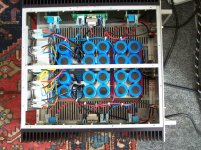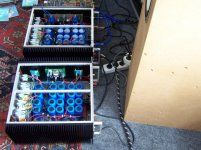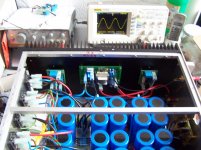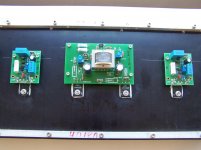I am at the moment adjusting the bias on my build,so far so good!
I am setting it at 1,55A cause that is max what the potentiometer will let me to...But I think that is enough heat anyway almost to hot to touch.
I was thinking if I am going to trim the second hand harmonic with the soundcard in my laptop,will I have to connect a potentiometer inbetween
so that I can lower the signal?
I am setting it at 1,55A cause that is max what the potentiometer will let me to...But I think that is enough heat anyway almost to hot to touch.
I was thinking if I am going to trim the second hand harmonic with the soundcard in my laptop,will I have to connect a potentiometer inbetween
so that I can lower the signal?
The standard measurement of Zo at 1 KHz using a purely resistive load is not enough. It misses woofer behavior; for example its damping as you noted above. I make a habit of profiling the impedance of the loudspeaker woofer in the range of 30-150 Hz by operating the amp under test in open and closed loop. The familiar impedance of the woofer versus frequency profile [peak at resonance] under closed loop is not a good sign.After lots of listening and tweaks, I have decided that the F6CC is not for my listening taste. The problem with the F6CC and the F6 appears to be the low damping factor and my B&W CDM1 speakers. Those amplifiers might do better with open baffle designs, but cause lots of low frequency resonance issues with my speakers.
I just finished an F4 build and think that it will be my preferred, everyday amplifier. I am currently listening to it driven by a Buffalo-IIISE DAC modded to deliver about 7 volts peak single-ended. That peak output is a bit low so I will add a BA-3 front end to the F4. The F4 really sounds great.
Best regards
I like Zen Mod's rule of thumb. lhquam was [conceptually] caught between replacing either amp or his loudspeaker. He kept the loudspeaker and chose F4 instead. Fortunately, he has done a lot of enjoyable [and admirable] work on F6 and F6CC; albeit leading to this unpredicatable outcome.ZM always says FW amps for real speakers and XA stuff for sissy speakers.
Sorry, only intelligent.....thing I could come up with.
Semsouth matching effect on perceived F6 sound
Hi,
I would like to report some results of my F6 sound perception and it's dependency on matching quality of Semisouth transistors.
I build an F6 based on boards borrowed to me by Generg (Thanks !) -
I inserted SS R125, which I bought matched to around 1.3 Vgs at 1.5 Amp Id.
The F6 with this transistors sounded very very quiet (no noise), but also less detailed and kind of very boring. I thought that it is very dominant on 2nd harmonic, which was very noticeable.
I thought of course that this could not be the amp that was praised on 6moons and by others.....
First two images attached are THD measurements taken at 1 Watts (2.83 Volts @ 8 Ohm, 1 khz). Althought the transistors were bought 'matched' both channels left/right are very different. Also THD is extreme high, e.g. 0,059% on right channel !!l
Matched Semisouth LEFT Channel THD:
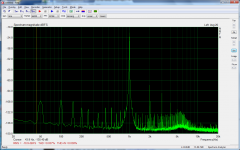
Matched Semisouth RIGHT CHannel THD:
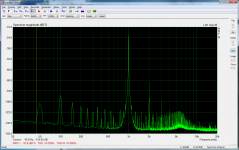
Sound was kind of disappointing with above transistors, although bought matched.
I did not have high hope on improvements, but tried curve-tracer matched Semisouth, also obtained from this forum.
WHAT A SURPRISE !
Suddenly the F6 had much more detail, well defined spatial definition of instruments and singers (ability to locate them on the virtual stage), and what was most impressing some kind of 'magic' to it, that draws your attention to the music. Instruments and singers were right in front of me. Last but not least I stopped analyzing, sat down and started to listen through my music collection.....
Later I did also an analysis on THD of this curve-tracer matched Semisouth, and was suprised to find: That both channels - left and right - had almost same - VERY LOW ! - THD figures and also very close 2nd /3rd harmonic relationship.
The sound - to my ears - was magical - reminding me on that magical sound I liked so much from the original J2 amp.
THD measurements of curve-tracer matched semisouth:
Left channel:
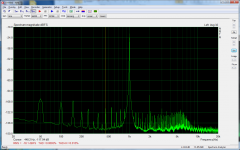
Right channel:
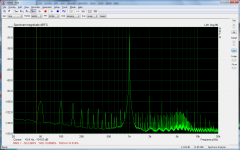
In Summary - I now know that also transistor matching quality has an impact on wether an amp sounds boring and less detailed or wether it sounds detailed and magical !
I didn't ever expect this though.....and not to this extent....as I was thinking I had used matched transistors in the first place....
Generg will borrow his curve-tracer to me, and I'll analyze the bad sounding "matched" transistors. Will post results, but might take a few days....
Hi,
I would like to report some results of my F6 sound perception and it's dependency on matching quality of Semisouth transistors.
I build an F6 based on boards borrowed to me by Generg (Thanks !) -
I inserted SS R125, which I bought matched to around 1.3 Vgs at 1.5 Amp Id.
The F6 with this transistors sounded very very quiet (no noise), but also less detailed and kind of very boring. I thought that it is very dominant on 2nd harmonic, which was very noticeable.
I thought of course that this could not be the amp that was praised on 6moons and by others.....
First two images attached are THD measurements taken at 1 Watts (2.83 Volts @ 8 Ohm, 1 khz). Althought the transistors were bought 'matched' both channels left/right are very different. Also THD is extreme high, e.g. 0,059% on right channel !!l
Matched Semisouth LEFT Channel THD:

Matched Semisouth RIGHT CHannel THD:

Sound was kind of disappointing with above transistors, although bought matched.
I did not have high hope on improvements, but tried curve-tracer matched Semisouth, also obtained from this forum.
WHAT A SURPRISE !
Suddenly the F6 had much more detail, well defined spatial definition of instruments and singers (ability to locate them on the virtual stage), and what was most impressing some kind of 'magic' to it, that draws your attention to the music. Instruments and singers were right in front of me. Last but not least I stopped analyzing, sat down and started to listen through my music collection.....
Later I did also an analysis on THD of this curve-tracer matched Semisouth, and was suprised to find: That both channels - left and right - had almost same - VERY LOW ! - THD figures and also very close 2nd /3rd harmonic relationship.
The sound - to my ears - was magical - reminding me on that magical sound I liked so much from the original J2 amp.
THD measurements of curve-tracer matched semisouth:
Left channel:

Right channel:

In Summary - I now know that also transistor matching quality has an impact on wether an amp sounds boring and less detailed or wether it sounds detailed and magical !
I didn't ever expect this though.....and not to this extent....as I was thinking I had used matched transistors in the first place....
Generg will borrow his curve-tracer to me, and I'll analyze the bad sounding "matched" transistors. Will post results, but might take a few days....
Makes quite a difference, doesnt it. Unfortunately, it is this very thing that makes this frustrarting amp. Other fets need to be tried. Kasey has had good luck with a ROHM product and when i get the chance, the Cree will be tried. Makes quite a difference in the sound to have it right.
..... albeit leading to this unpredicatable outcome.
not so much unpredictable
when speaking of troublesome load , we know which muscular amps - most probably all from PL and just some of FW stable are adequate
You and your rule of thumb have the making of this solution. Determine whether the loudspeaker of the DIYer is a troublesome load or not by using certain applicable criteria. Then prescribe an FW amp to properly mate with it; which will be the best candidate for the DIYer to assemble. Would lhquam have assembled F6CC had he known a priori or predicted with confidence that a certain mismatch between this amp and his loudspeaker will exist?not so much unpredictable
when speaking of troublesome load , we know which muscular amps - most probably all from PL and just some of FW stable are adequate
I like Zen Mod's rule of thumb. lhquam was [conceptually] caught between replacing either amp or his loudspeaker. He kept the loudspeaker and chose F4 instead. Fortunately, he has done a lot of enjoyable [and admirable] work on F6 and F6CC; albeit leading to this unpredicatable outcome.
I have only temporarily given up on replacing my speakers. I am looking at a variety of DIY speaker projects that might provide a speaker more suitable with the F6 (and similar low DF amps) and will also work in my listening environment. A difficult balancing act.
DIYers advantage
comment to post
http://www.diyaudio.com/forums/pass-labs/216616-f6-amplifier-515.html#post3598291 from DSDJOY
from DSDJOY
for me it shows that Vgs matching alone is only a fragile compromise... and that the Semisouth might even more difficult to match than the IRF types...
Nelson wrote already 2003 here
http://www.firstwatt.com/pdf/art_mos_test.pdf
that one of the advantages of DIY could be the thouroughfully measurement of the components and suggested an easy to build circuit to measure all important data of a MosFet.
I did not meet anyone who build this device.... not even me....
It was easier to buy a curve tracer for PC.... but the circuit Nelson suggested can even measure Ciss! Of course no "comfort" ......
So it seems we do use enough the possibilities we have as DIYers in this point....
Or am I wrong?
comment to post
http://www.diyaudio.com/forums/pass-labs/216616-f6-amplifier-515.html#post3598291
for me it shows that Vgs matching alone is only a fragile compromise... and that the Semisouth might even more difficult to match than the IRF types...
Nelson wrote already 2003 here
http://www.firstwatt.com/pdf/art_mos_test.pdf
that one of the advantages of DIY could be the thouroughfully measurement of the components and suggested an easy to build circuit to measure all important data of a MosFet.
I did not meet anyone who build this device.... not even me....
It was easier to buy a curve tracer for PC.... but the circuit Nelson suggested can even measure Ciss! Of course no "comfort" ......
So it seems we do use enough the possibilities we have as DIYers in this point....
Or am I wrong?
To add to Generg's comment.
http://www.diyaudio.com/forums/solid-state/240712-cfa-topology-audio-amplifiers-13.html#post3596502
http://www.diyaudio.com/forums/solid-state/240712-cfa-topology-audio-amplifiers-13.html#post3596502
- Home
- Amplifiers
- Pass Labs
- F6 Amplifier
